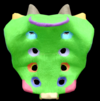Lab 1 Flashcards
(69 cards)

inferior nasal conchae

nasal bones

maxillary bones

zygomatic bones

mandible
Bony Orbit
Frontal, maxillary, ethmoidal, lacrimal, zygomatic, palatine, sphenoid

sphenoid
part of the lateral wall of the neurocranium

zygomatic arch (process of zygomatic and temporal bones)

coronal suture (frontal and parietal)

squamous suture (temporal and parietal)

sagittal suture (parietal bones)

lambdoidal suture (parietal and occipital)

superior nuchal line (blue)
superior limit of the neck

external occipital protuberance

exernal acoustic meatus

Pterion/temple (sphenoid, frontal, temporal, and parietal)
thin-can fracture easily

Hard Palate (palantine processes of the maxiallary bones and horizontal plates of the palantine bones)
separates nasal cavity from oral cavity
between the temporal and occipital bones

foramen lacerum
travels through the sphenoid

foramen ovale
through the temporal

carotid canal
between the styloid and mastoid process in temporal bone

stylomastoid foramen
between the temporal and occipital bones

jugular foramen

foramen magnum
where the brain connects to the spinal cord

occipital condyles
articulate the atlas







































